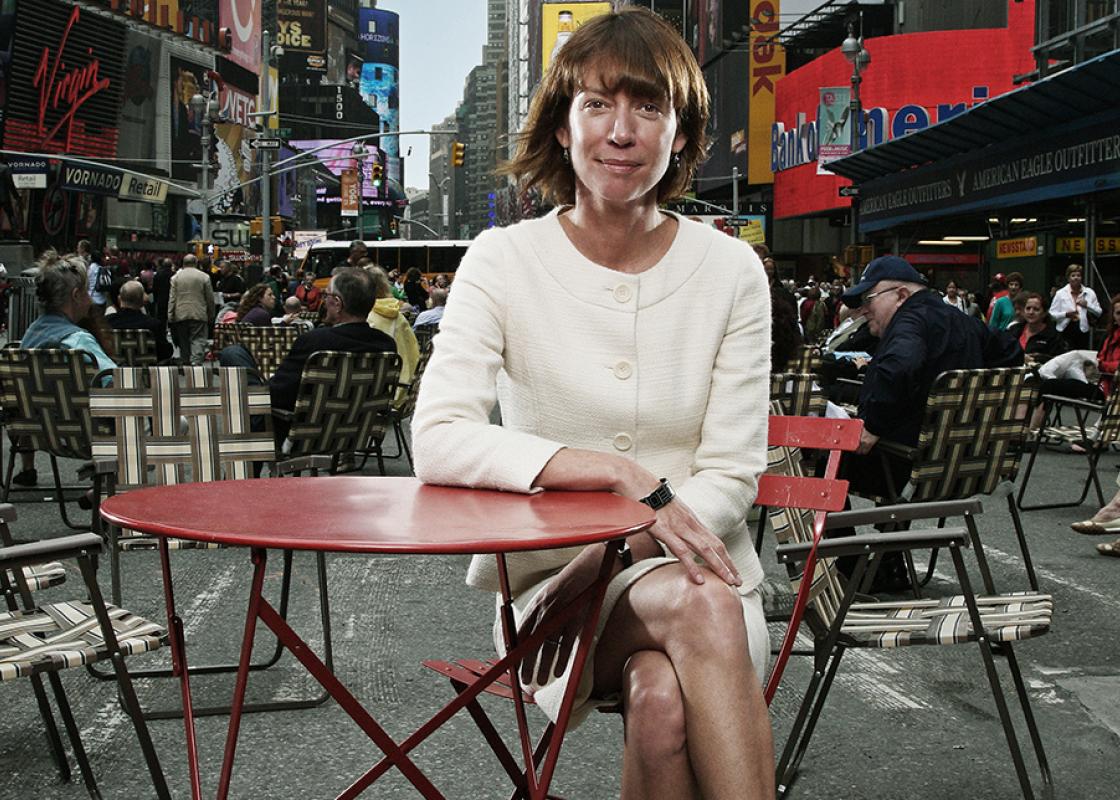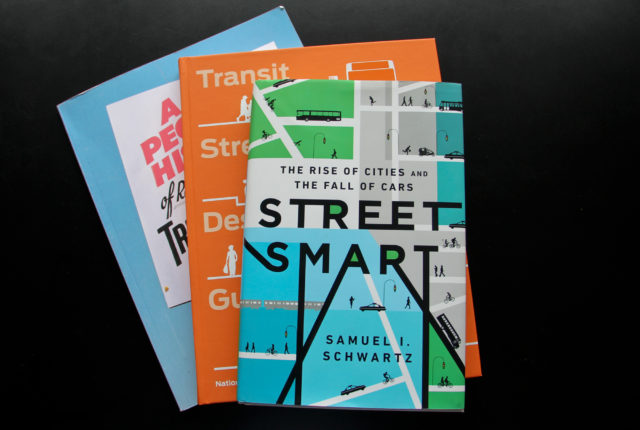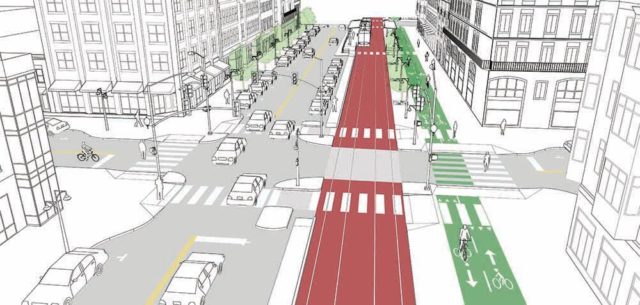Books on urbanism and transportation innovation are having their moment. Here’s a look at five that have come out in the last year alone, starting with Streetfight by Janette Sadik-Khan, who is in Houston this week for a talk sponsored by Rice University's Kinder Institute for Urban Research, Wednesday, May 18, at 6:30 pm, at The Museum of Fine Arts, Houston.
Streetfight by Janette Sadik-Khan with Seth Solomonow (Viking, 2016)
The wounds are fresh. Sadik-Khan, the commissioner for New York City's Department of Transportation from 2007 to 2013, chronicles the bruising battles over the building out of 400 miles of bike lanes and 60 plazas. Though I followed the controversies over the years as they were reported in The New York Times, to hear it from her perspective is something else. I didn’t realize that the first experiments were not all that controversial. With paint and planters, an ugly triangle of pavement in DUMBO went from parking lot to well-used public space without much opposition. We could do that here. We have so many excessive expanses of concrete in Houston.
The big battles were over bicycle lanes on a street bordering Prospect Park and dedicated bus lanes through Midtown Manhattan. At some point, if Houston is to see the level of innovation that has taken place in New York, we may well need a heroic bruiser at the helm. We will have to make tradeoffs in Houston, the kind that set off “streetfights.” METRO’s plans for light rail on Richmond and Bus Rapid Transit (BRT) on Post Oak have produced battles, to be sure. At the same time, we are making huge strides with the Bayou Greenways without the battles. As I noted in my look at the draft Bike Plan, we have some more of these no-tradeoff opportunities to pursue.
What I appreciated most about Streetfight was that Sadik-Khan covered every aspect of her job. It’s not a great bicycling book (see Bikenomics by Elly Blue). Or a great pedestrian book (see Walkable Urbanism by Jeff Speck). Or a great transit book (Human Transit by Jarett Walker). Instead, you get an integrated view of all aspects of transportation. In fact, you can read the chapter on bridges and ferry terminals online here.
Start-Up City: Inspiring Private and Public Entrepeneurship, Getting Projects Done, and Having Fun by Gabe Klein (Island Press, 2015)
Unlike Sadik-Khan, who worked her way through various government departments, Gabe Klein went from executive at Zipcar to leading the District of Columbia Department of Transportation and later the Chicago Department of Transportation at a relatively young age. Despite this difference, both Sadik-Khan and Klein tell stories of rapid innovation and disruption of government as usual. Both books are like picaresque novels. The roguish outsider hero charges from adventure to adventure, armed with data, not lances. Who would have thought that the nerdy world of human-centered transportation — narrowing lane widths, widening sidewalks and extending them with "bulbouts," increasing bus frequencies, reducing parking requirements — could be so exciting? For so long, the engineering and design of our infrastructure have been done by anonymous figures. But it wasn’t always this way. As Christof Spieler notes in a short essay for the Summer 2009 issue of Cite (79), heroic engineers like Isambard Kingdom Brunel (1806-1859) once presided over heroic infrastructure projects.
Think of the massive changes, including the demolition of whole neighborhoods for thoroughfares, wrought by Baron Haussmann (1809-1891) in Paris and Robert Moses (1888-1981) in New York. The later gave rise to the critique Jane Jacobs made in The Death and Life of Great American Cities (1961) and a whole new policy regime of environmental review.
Most of projects undertaken by Sadik-Khan and Klein, however, were relatively minor. They retrofitted streets on small budgets. They tucked bike shares into the existing fabric as discretely as they could. By amassing small tweaks on a grand scale, Sadik-Khan claims the mantles of both Moses and Jacobs.
“Retrofitting our cities for the new urban age and achieving Jane Jacobs’s vision today,” she writes in Streetfight, “will require Moses-like vision and action for building the next generation of city roads, ones that will accommodate pedestrians, bikes, and buses safely and not just single-occupancy vehicles with their diminishing returns of our streets.”
For Klein, transportation innovation is more about bringing management techniques to city hall than politics itself. He’s more interested in setting goals, measuring progress, giving feedback to staff — the stuff taught at MBA schools — than the geeky details of street design.
A People's History of Recent Urban Transportation Innovation (TransitCenter, 2015)
This 75-page publication argues that “a civic sector that is resident-led, non-elite, and outside government — yet able to persuade local politicians to take risks — is paramount to the success of any city.” Written by Shin-pei Tsay with others at TransitCenter, the book looks at several cities and depicts the complex interplay of elected officials, city staff, advocates, media, and general public.
The report calls attention to people like Jon Orcutt, who was an advocate at Transportation Alternatives before Sadik-Khan brought him inside government as the head of her strategy office. I met Orcutt when TransitCenter (his current employer) partnered with the Kinder Institute on a workshop in Houston. He was understated. He listened as much as he spoke. The report notes that “[a]dvocates-turned-staffers can be instrumental in ensuring that change occurs quickly.” One of the report’s sources described him as “perhaps more important than Sadik-Khan.”
Besides looking at New York City in depth, the report also considers Portland, Pittsburgh, Chicago, Denver, and Charlotte. You get a sense of what is possible when state and city governments are in alignment, and the limits on what can be accomplished when they are not. For example, I didn’t know that Portland’s regional growth boundary came about in the early 1970s as the result of collaboration between a Republican governor with rural interests and a Democratic mayor with urban interests.
Street Smart: The Rise of Cities and the Fall of Cars by Samuel Schwartz (PublicAffairs, 2015)
If Sadik-Khan comes off as an in-your-face fighter, Samuel Schwartz casts himself more as an avuncular but sly veteran transportation engineer. For example, while working for the New York City traffic department, he surreptitiously removed a road through Prospect Park from official city plans. He also leaked information to advocacy groups and media, referring to himself as a “deep throat.”
He does admit jealously over Sadik-Khan’s success in carrying out the types of plans he had long pushed for, though his own accomplishments are many.
Schwartz tells the history of how automobiles came to dominate our streets, and he inflects each part of the story with his own experiences and his salty humor. The memoir sections serve a larger history. He also cites all sorts of studies to back up his calls for designing streets for humans. The one type of evidence he can’t find — showing that pedestrian-friendly cities are better for dating — he compensates for with personal anecdotes.
Houston's bus reimagining earns his praise. Nonetheless, he's not optimistic about the stalemate between those seeking and those opposing more transit options. Here's how he describes our political situation: "More than half of Houston's residents, according to the Kinder Institute's Houston Area Survey, want to live in a mixed-use community that isn't completely dependent on the automobile. However, there's the other half, Houstonians who believe themselves under attack from anti-car zealots who want to turn their city into — horror of horrors — Portland."
Transit Street Design Guide by the National Association of City Transportation Officials (Island Press, 2016)
If you try to read all these books in quick succession, as I have, you will likely reach a saturation point. Too much optimism can make you grumpy. You also notice all the gaps, like the absence of serious thought about the future of cul-de-sacs and freeways. And you start to realize that despite having read so many pages, you are no expert. That if you were handed the keys to a public works or transportation department, you would have nothing to go by but dozens of anecdotes. Should that happen to you, pick up the Transit Street Guide. It is both clear and technical. Study the difference between a “near-side in-lane bus stop with a conventional bike lane” and a “far-side in-lane bus stop with protected bike lane.” Pour over the details of a “one-way transit street with contraflow lane and bi-directional protected bike lane.”
One of the refrains about Houston’s mostly unsafe streets is that the city follows a car-oriented manual. And that manual is based on national guidelines. What the National Association of City Transportation Officials (NACTO) has done is to codify all the bold experiments carried out in New York City, Denver, Portland, Toronto, and elsewhere. Now, planners in Houston have some backup. They can refer to an authoritative text. Advocates and neighborhood organizers can as well.
This one’s not for reading straight through. It’s a reference book. I flip to a new page every now and then, and dream.












